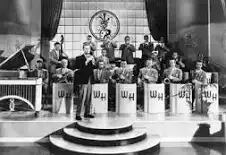12 Ending the Progressive 40s
Next midterm will be everything from 9 Count Basie (Swing) onward.
We'll continue listening to Thelonius Monk and his pieces. Note that his pieces often had a lot of asymmetrical rhythm.
Played starring drummer Art Blakey.
Notes:
- The starting drum beats may feel rhythm, but they are there to go in and out of the beat.
- Starring 12-bar blues.
- The melody is very recognizable, doing
- You can hear Thelonius Monk playing a lot of dissonance on the piano soli. This was a major part of his style.
- You hear Sahib Shihab on the sax.
- You hear Milt on the vibraphone.
Made by Thelonius Monk.
Notes:
- The chorus template is (in order):
- 4 bar theme
- Variant
- Highly Syncopated with a lot of blue notes
- Still running off the main 4 bar theme though.
- 6 note cluster motif
- Using a lot of blobby motifs, with dissonance.
- Linear Blues line
- Spacious Variation
- There's entire measures of silence so that it acts as a break from the previous choruses
- Variation - repeat note
- Repeats chorus 2
- Flurry of Notes - repeated phrase
- Mainly runs like he's a sax player.
- Clashy improv notes, space
- Like two solos being played that want to go do different ideas.
- A lot of Art Blakey
- Here Thelonius Monk takes a backseat, but Blakey adds some rhythmic variation to his playing so the solo has to be a bit different.
- Rapid fire notes
- Almost like Trumpet Style, influenced by Earl Hines
- Sparse and dissonant
- The chords almost don't agree, but they largely do (mainly the 7th? that doesn't agree, it's like a major 7th)
- Dissonant
- Much like (12)
- Vaguely repeats the main theme
- It's more cut than anything, like there's parts of the melody that are forgotten.
- 4 note variant
- Continuing that line of thinking he is cutting more and more
- Empty
- ... until there is only a few notes left that die out ...
- Bass Solo (by Percy Heath)
- ... which sets up Percy's solo!
- (repeat Bass Solo)
- Drum Solo (3 choruses)
- A cool part is he is hitting the stick on the drum rim, but this is tightening the tension so that he can create a bend in the sound.
- (repeat Drum Solo)
- ...
- Theme again
There's two takes. We'll really want to analyze Thelonius Monk's solos between takes. First let's look at take 2:
Here take 1 is the first run-through:
Notes:
- Still a 12 bar blues
- The second take has a lot more melodic and rhythmic variation than the first.
- The first one feels very somber, mainly because the second one has a lot more runs than the first. This was a lot more of Monk's style.
- Both have these triplet into eight feel (5 bar motif)
- We actually get to see Miles Davis in this one
- The first take I'd argue is very experimental in its solo, while the motifs in the second one is more cohesive (motifs change, but they style connects between the two).
An Opposition to Bebop
Featuring Stan Getz, this big band is known for a strong reaction against Bebop (Bop).

They wanted to get back to the more standard area of jazz, like swing.
This is one of Woodie Herman Big Band's initial songs going against the Bebop (Bop) era.
Notes:
- Form is AABA
- The second tenor solo is Stan Getz, before he would start playing Bossa Nova and other Latin Jazz
- This is a much more relaxed asthetic, in comparison to say Count Basie and His Orchestra. It's almost in the name "fox trot".
- In contrast to Bebop, this is supposed to be danced to, not merely listened to.
Going into the Cool/Hard Bop
Founded by Baritone Saxophonist Gerry Mulligan, later Miles Davis would join this to try to incorporate the idea of cool jazz.

A lot of these people were from the West Coast (see the image). They even mentioned how people like Charlie Parker could only survive in NYC and on the east coast. The west coast Bebop (Bop) never took off, but cool jazz did take off.
Played by the Gerry Mulligan Quartet.
Notes:
- The trumpet player is Chet Baker, and Bari. Sax Player Gerry Mulligan
- Much more mellow than standard Bebop (Bop)
- AABA Jazz Form
- The two melodies (TPT, BS) get to mix and mesh together in the non-solo sections.
- Notice how the TPT and BS are not even hitting their large register ranges! This is in large contrast to players like Louis Armstrong (back in the day) or closer players (in chronology) like Charlie Parker.